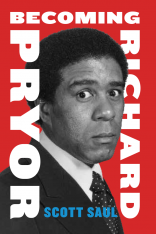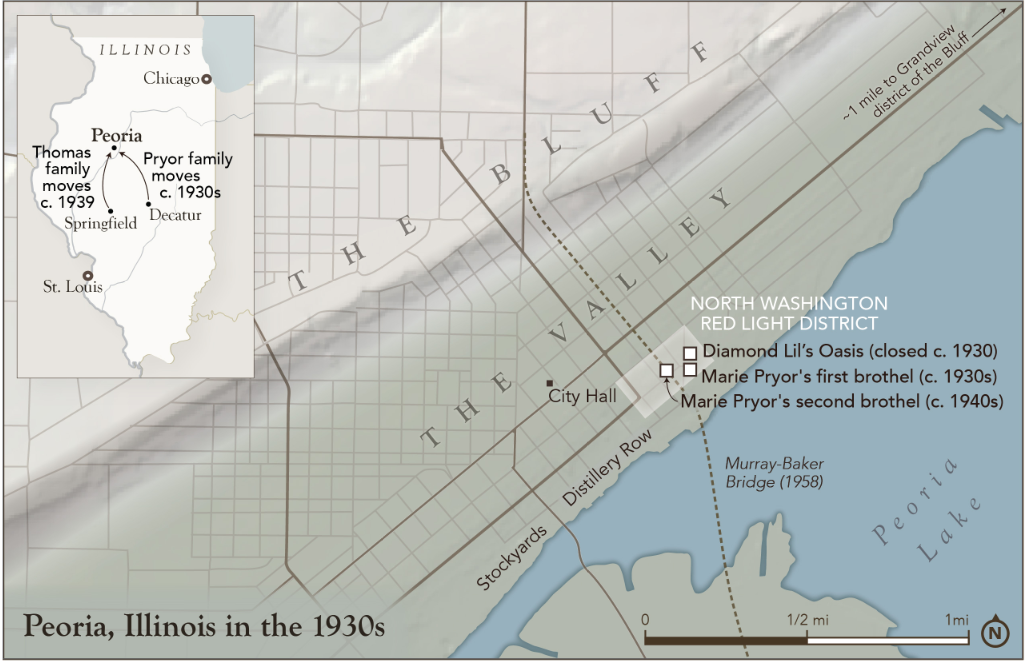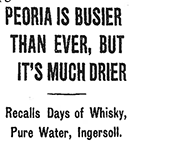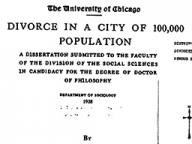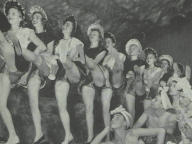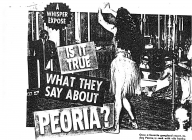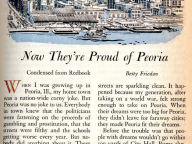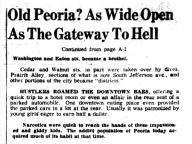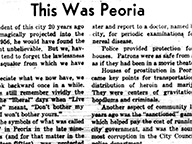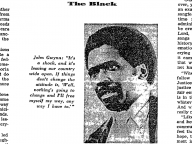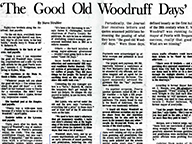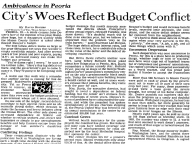A town divided between its working-class Valley and its middle-class Bluff
Peoria: An Introduction
On the vaudeville circuit in the early twentieth century, “Peoria” became the setup to a joke about a heartland city that was the most boring place on the planet. “Do you know Peoria?” “Oh, yes—I spent four years there one night.” Or: “Why did you two get married?” “We were in Peoria and it rained all week.”
By the 1930s, when Richard Pryor’s grandmother arrived in Peoria, the jokes about the land of “the rube and the boob” bore only the thinnest relationship to the actual city. Far from a blandly typical midwestern town, Peoria was perhaps America’s most unchecked sin city. Peorians were different, looser: they “talk[ed] about corruption the way people elsewhere talk about baseball,” one reporter noted, and divorced at double the rate of Illinois and the rest of America. This was the city that provided the foundation for Richard Pryor’s comedy.
“City of Good Spirits”
A hundred and seventy miles southwest of Chicago, Peoria rose up from the western bank of the Illinois river, which connected it to the Mississippi and points beyond. In the early nineteenth century, it had been settled by homesteaders from Virginia, Kentucky and Maryland. In the 1840s, a wave of German immigrants brought with them their native fondness for beer and their knowledge of how to manufacture it. Beer and whiskey became the economic cornerstones of this “city of good spirits.”
Though only a mid-sized city, Peoria began boasting of its unmatched achievements. Starting in the 1880s, it hosted the largest distillery in the world; its breweries and distilleries required so much corn from the nearby corn belt that Peoria became the largest corn-consuming market in the world. Later, the arrival of Caterpillar’s headquarters and the LeTourneau factory made the city the earth-moving capital of the world too.
The City of the Valley, the City of the Bluff
Peoria was also a city of violent contrasts, disparities so extreme that they begged to become grist for satire. The city was divided geographically and culturally between its industrial valley, which skirted the river, and the bluffs that looked down from a height of three hundred feet on the valley below.
On a night on the bluffs in the 1940s, a pair of lovers might bask in clear, silvery moonlight; below, their valley equivalents might inhale a yellow fog that carried distillery fumes and the aroma of hog intestines. Above: magnificent estates inhabited by the city’s managerial class. (Theodore Roosevelt was so moved the area’s palatial homes, gentle curves and expansive vistas that he called its main street “the world’s most beautiful drive.”) Below: streets thick with the modest frame houses of machinists, carpenters, salesmen and waitresses. Outhouses were common.
The politics of the bluffs were the politics of “reform.” Its inhabitants hoped to scrub city politics clean as a whistle. One of its noted residents, the industrialist Robert LeTourneau, took as his slogan “God Runs My Business.”
The politics of the valley were “liberal,” which in the parlance of the day meant open gambling, open drinking, and open prostitution, all held together by a network of underworld businessmen who followed a principle of mutual self-interest. In Peoria, “live and let live” meant, according to the Peoria Journal Star, “Don’t bother my racket and I won’t bother yours.”
The Culture of a “Wide Open” City
While the bluffs controlled the manufacturing economy of Peoria, for the first half of the twentieth century the valley controlled its politics, and for a simple reason: it had the votes.
In the heyday of Prohibition, Peorians supported repeal by a margin of twenty to one. From 1902 until 1945, the face of “Roarin’ Peoria” was the thin, flushed, cigar-chomping mug of Ed Woodruff, who served as the city’s mayor, off and on, for twenty-four years. His philosophy, which he made into his city’s, was “Peoria likes to live and doesn’t want to be told what to do and what not to do all the time.”
A professional criminal familiar with the Capone organization landed in Peoria and was shocked. “When I had left Chicago,” he said, “well, things had been pretty wide open, but they weren’t as wide open as they were in Peoria. Which was something for me to look at—wide-open gambling, wide-open prostitution, everything running wide open. With no interference from the law.”
“Wide Open” but Segregated
The liberal ethos of Peoria did not extend to the realm of civil rights for its black residents, who were 3 percent of the city’s population in 1940, the year of Richard Pryor’s birth. Like many northern cities before World War II, Peoria was legally integrated but, on a practical level, segregated from top to bottom.
None of Peoria’s hotels admitted blacks. Many of its laundries would not take clothes worn by blacks; only two restaurants downtown served blacks; and most movie theaters seated blacks only in the mezzanines, while two movie theaters banned them entirely. (As a child in the 1940s, Richard Pryor loved losing himself in movie theaters nonetheless.)
Most of Peoria’s largest employers essentially refused to hire blacks. Caterpillar Tractor, the largest employer in Central Illinois, had no blacks on its payroll before World War II. The local power utility had one.
In the coming decades, as black Peorians challenged the structures of segregation in their city, such overt discrimination became more and more rare. But the legacy of segregation endured.
Much More Than “Anytown, USA”
Ever since vaudeville entertainers made famous the question “Will it play in Peoria?”, Peoria has stood as a symbol for Middle America. Generations of journalists and politicians have evoked Peoria as an almost mythic “heartland” city: typically, when President Richard Nixon worried about backlash from the liberal Eastern establishment, his advisor John Erhlichman advised him, “Don’t worry, it’ll play in Peoria.”
But Peoria is much more interesting than its myth suggests. Its local history embraces a set of conflicts—for instance, between those who loved “Roarin’ Peoria” and those who wanted to clean it up, between those who supported segregation and those who battled against it. There were always many Peorias within Peoria, and even within “Richard Pryor’s Peoria.”
